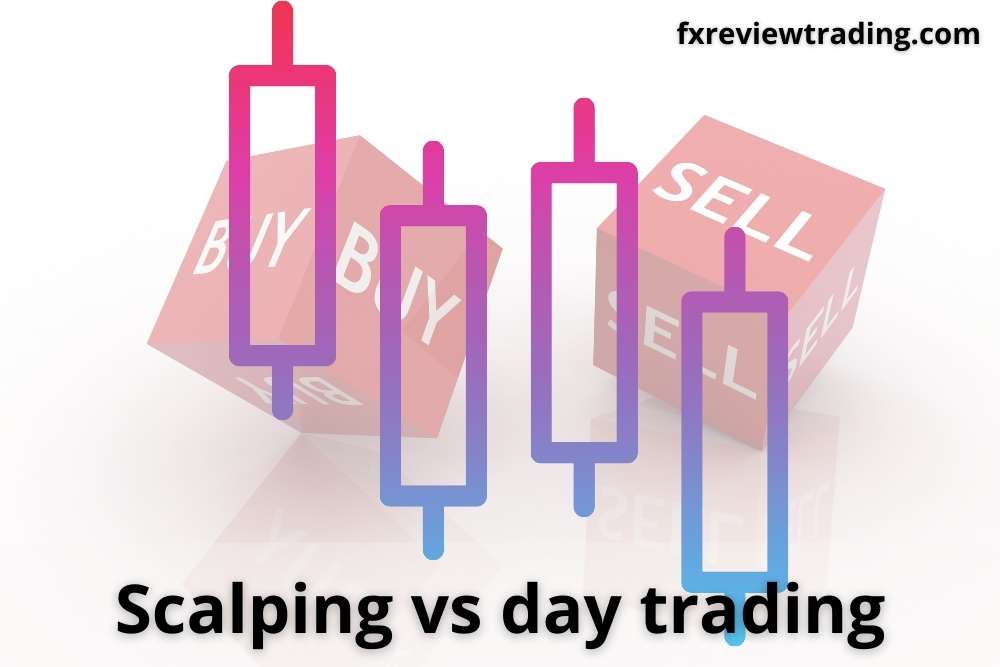A trading strategy is the financial trading plan that investors and traders design to have a smooth and successful experience. Traders use the trading strategies for long and short market positions depending on the instrument trader invests. There are several trading strategies that traders can use for the various markets. However, some trading strategies have popularity in the market.
Investors should apply strategies that are well researched and analysed with the market. These work with the market due to consistency, objectivity, verifiability and quantifiability. Some of the strategies are scalping, day trading, swing trading, Relative strength index etc.
Although there are many to use for trading, the primary focus will be on the two strategies in this article. The scalping vs day trading both are used for quick actions and trade for a few minutes or hours in a day with multiple trade positions.
Scalping
When traders have years of experience in the financial markets and want to earn through small trades and immediate benefits, they use a scalping strategy. Scalping is a trading style that aids traders to make a profit from small fluctuations in the price of the security traded. The traders are experts and know the market well to decide on the exit; therefore, scalpers have an exit strategy to limit the trade loss.
The traders try to eliminate the loss and trade in many small investments with small gains. Thus, traders hold multiple positions in a day with the best trading tools to assist. It can use trading tools such as news, online brokers such as ETFinance, timeframes, charts etc.
However, traders need to be quick enough to gain the benefit from the change. As the fluctuations keep taking place, and if the traders are not quick, they can face a loss.
How does Scalping work?
The scalping strategy is understood by now, but how to use the scalping strategy? For a better understanding of the strategy, traders should be aware of its use. So, let’s begin with grasping and learning it better.
The scalping strategy works on the assumption that the security trade will finish the initial stage of a movement. Although, the further movement or change is not known. Some securities may increase their value while others may not advance. In this, the trader focuses on increasing their wins from the trades and not the size of their win.
Traders invest in multiple trades and try to achieve more in small profits, not worrying about the size of their profit. The longer time frame traders use the scalping strategy and gain from the small investments, which could be half or less for their trade. However, the gain in total is higher than the loss in the scalping strategy.
Scalpers of financial markets have a high profit ratio in comparison to the loss. This requires a professional approach and quick trade decisions with market understanding.
Key prospects of Scalping:
Scalping strategy has main premises that help investors:
- Risk: The strategy has a limited risk because of the less market exposure. Thus, minimising the possibility of negative trade or event.
- Trade: The trade in scalping is small; therefore, easier to obtain profits. Traders invest in small trades with small investments, profiting from the market fluctuations. The smaller moves are easier to make in the financial markets than the bigger ones.
- Frequency: The small market changes are frequent in comparison to larger moves. The scalpers have ample opportunities to trade.
Scalping is a good strategy if used properly; it can make small profits that could be bigger than the normal trade profits. However, scalping vs day trading are significantly different, and we’ll know more about the two trading strategies.
Swing trading vs Scalping
The title of the article, scalping vs day trading, has many other strategies to be used for a confident trade. Swing trading is one of the trading strategies.
Swing trading is the financial market strategy that operates on speculation trading. In the swing trade, traders hold the tradable security for a day or two to generate profit from the swings in the prices. The swing traders hold the position for the long term in comparison to scalping and day trading.
However, the swing traders hold the security for less time than other strategies of the market. It cannot trade in security for months and years. The swing traders buy the securities or short sell them for trading.
Swing trading vs scalping has many differences, and one of them is that the two have different time periods for the trade. One is a day trade while the other could be held longer than a day. Swing trading is set on mathematical objectives, based on which swing traders buy and sell.
Swing traders eliminate the emotional and subjective aspects for trading, using the trading algorithm or trading system for technical analysis of the markets.
In swing trading vs scalping, the traders of scalping enter and exit the markets frequently, while in swing trading, they hold the position for a day or two. Scalping is a type of day trading, although a bit different. It has numerous or multiple trades with small holding for a few seconds or minutes. While swing trading is more than that, swing traders stay for a bit long in the market and trade.
The gains of swing trading vs scalping are also different, as the positions are small for scalping and longer for swing trading. In scalping, the profits are small due to small positions, whereas the swing traders enjoy high profits.
Scalpers have limited market exposure in contrast to swing traders; however, the swing traders are not quick in their actions while scalers are quick to trade. Swing trading vs scalping has vital areas to affect the trade; swing trading does not trade around the spreads; it has other factors as well, while scalping trades buy and sell based on the spreads that are the bid and the ask price of the security.
The charts of swing trading are for a long period, whereas the scalping has short charts ranging from 1 minute, 5-minute and 15 minutes etc. The scalpers need to be highly focused, dedicated and have enough time to analyse the market.
On the other hand, swing traders could be a bit more relaxed than scalpers. Swing trading vs scalping is a good topic to understand both strategies.
Scalping vs Day Trading
The two essential trading strategies of financial markets, scalping and day trading, are similar in some senses and different in others. In the paragraph, the difference between the two is discussed as the sub heading and the title of the article mentions.
Scalping vs day trading has differences in their trade practice, time frames and operations etc. Here, we will analyse these points one by one.
Time frame: The time frame of scalping vs day trading is different depending on the trade. The scalpers and day traders use time frames; scalpers have short time frames such as a few seconds or a minute or two. In contrast, day traders have long time frames in a day; it could be for a minute or an hour.
Account size: The account size of scalping vs day trading is also different. Scalpers have big account sizes as they take high market risks. In comparison, day traders have a medium account size. As a result, the scalping strategy has a high lot size in their trade account with good profits at the end.
Trade Experience: Scalpers have trade experience and keep trading without waiting for the result. Day traders also have experience; however, they are less aware of the market than scalpers.
The differences in the two strategies are necessary as these make the trade different and unique for both scalpers and day traders. Scalping vs day trading points gives a quick sneak peek into the trading strategies in brief.
Day Trading
As the name suggests, day trading is a day’s trade with investors investing for minutes, hours, or a whole day. The day traders may hold multiple positions or a single day trade position to invest in the financial markets. The day traders buy the securities and subsequently sell them in some time to gain profits.
The trading strategy takes advantage of small market fluctuations with high liquidity. Day trading works the best with high liquidity and volatility, providing traders with adequate conditions to invest and earn. However, traders should be careful with day trading as the risks are also high for the traders.
Scalping vs day trading is quite a topic to discuss; traders can know both the investments and their rules of trading. But, both have one thing in the same, which is day trade with small investments.
How does day trading work?
Day trading works completely different from scalping; that’s why the topic of discussion is scalping vs day trading. The trading strategy, day trading, operates on a volatile market; the uncertainties of the market make traders earn and enjoy the trade. The day traders have to be careful and aware of the market updates to trade successfully.
The traders earn from the price changes and frequently check the market to trade. Traders buy and sell the securities when the security is trading at a high value, then trader buys the security, and when it goes low, they sell to minimise the loss and earn profits.
The day traders buy and sell, speculate, and use the charts, indicators, and time frames to have a smooth trade. Traders use 1 minute, 15 minute and hour or two hour time frames to trade. The investments of day trading could be small and high depending on the trade instruments and make traders earn profits.
Swing Trader vs day trader the two traders are contrasting due to the various factors. A swing trader trades in the market with small and large investments and could be in time frames from a day to two but not as long as months or years.
Swing traders enjoy good profits and have several market opportunities. They invest in the market in the short term; they have swings in securities which are studied in charts with trade over days.
Day traders are also studied through charts with small profits in a day. The day traders work independently with flexible working and can take time off when required. The traders have high-frequency trade, use hedge funds and invest in millions to have advanced trading.
Understanding scalping vs day trading
Profits and drawbacks of scalping and day trading, in the scalping vs day trading, two have been compared. But in the paragraph, the article has discussed pros and cons.
Scalping Pros and Cons
Scalping vs day trading is different, and both have their rules of trading; here listed are the pros and cons of a scalping strategy.
Pros:
- The scalpers of the financial market trend in the market direction and are not stuck in the reversals of the market.
- The percentage of a win in the scalping strategy is high; a professional scalping strategy usually has an 80% win rate.
- The traders of scalping trade quick and have great market knowledge.
- The investments in scalping are low; thus, it requires a small capital investment.
- It is a profitable strategy for the investors.
Cons:
- The traders require precision for trading with scalping.
- Traders need to be quick with the investments, entry and exit, or they may lose.
- The brokers that provide scalping may have a commission for the service.
- It requires wide market knowledge.
Day Trading pros and cons:
Pros:
- It does not involve overnight risk for the traders, which is a beneficial point for day traders.
- Traders have ample market opportunities, and the uncertainty of the market is favorable for the traders.
- The trade is fast paced, and traders have quick actions
- It is a day trade with multiple positions.
Cons:
- There are multiple transaction fees in day trading.
- The day traders have to study and analyse the market; thus, it takes a lot of dedicated time for the investors.
- Small investments make small profits.
- If a trader faces a big loss, the earnings may be lost in the trade.
Conclusion
Scalping vs day trading is a key topic that traders should be aware of; traders analyse the market to earn from both the trades. The investments in scalping and day trading are low, thus helping traders earn small profits from the trade. The article has discussed the two in comparison and also with the swing trading strategy for understanding the trade strategies.
However, in scalping vs day trading, one point to be kept in mind is the market understanding. A trader requires good research and analysis before investing.








